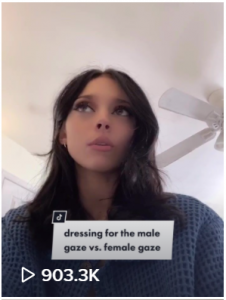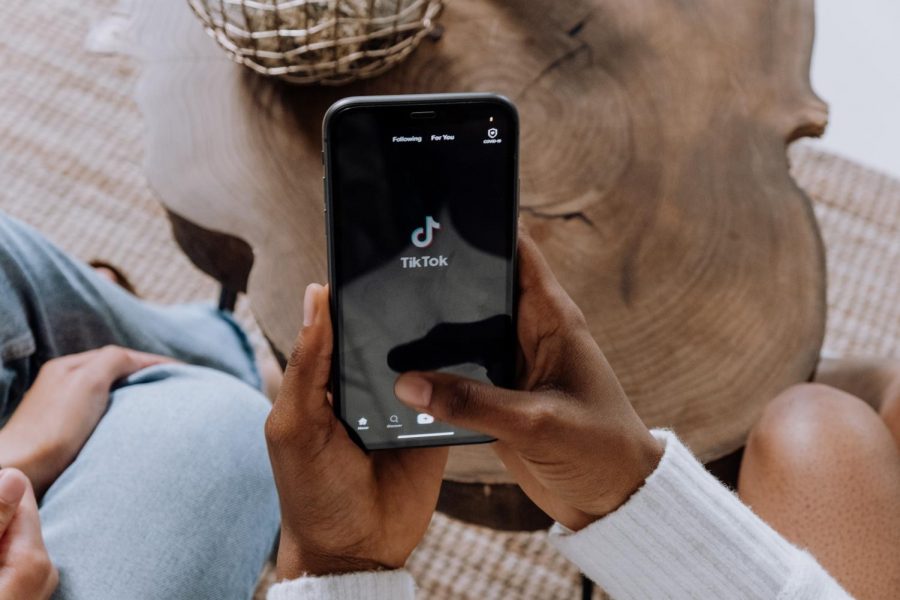TikTok Trend of ‘The Female Gaze’ Highlights Gender Freedom and Expression
September 4, 2021
Let’s set the scene: you are arriving home from a monotonous workday. You throw down your belongings and flop wearily onto your couch. Recognizing how an outside viewer may perceive your disheveled state causes you to smooth your unruly hair and your clothes to accentuate the curves on your body. You now look beautiful for the idea that someone may being watching, judging. You feel the presence of the male gaze.
The Male Monocle
The male gaze has its persistent claws stuck into the flesh of our society — the concept is a key player in feminist theory, describing the way women and non-men are viewed as sexual objects through the hegemonic male perspective. However, recently the concept has been addressed on social media.
On TikTok, a trend has been going around where creators compare old self photographs with their current physical expression and style. For the large part, TikTokers share initial pictures in line with the ideals of the male gaze and then frame current styles as those that break free from the gaze’s grasp. Thusly, the trend has birthed an ideology — the female gaze.
While not a new concept, the female gaze has been reinvented by TikTok into its own aesthetic that seeks to push beyond the boundaries of the binary. TikTok’s female gaze does so by calling in a multitude of concepts including gender aesthetics, patriarchal norms, compulsory heterosexuality, identity and intention. With that glued in mind, what does TikTok’s female gaze actually entail?

(Courtesy @lilrotini)
Aesthetics and Intentions
“I only ever found my personal style when I stopped dressing for male validation and the male gaze because it was boring,” TikTok creator @lilrotini comments in her video, with over 285 thousand users liking in agreement. The fashion stylist Arabella breaks down her past fashion choices and explains how she consciously dressed for a male audience, wearing “things that would show my body off, but they never were really cool.”
In the sea of videos following this trend, users’ appearances for male validation have some key visual similarities. Outfits are very simple, form-fitting and grace a muted, pastel color palate. Users typically wore minimal layers in favor of high-waisted pants with a cropped shirt combo. T-shirts are often V-neck, makeup is simple and feminine and boldness is avoided.
Beyond the visual cues of the male gaze, intention also plays a big role in its definition. “The goal was for people to say, ‘She’s so hot!’ not [to use] my platform to express myself,” comments user @lexie_jayy. For her, the intention behind her appearance was what connected her to the male gaze and not necessarily what she was wearing.
“Even though I’m still wearing a micro mini dress it’s not giving, ‘Oh my god, can I be your girlfriend?’ It’s giving ‘bad b*tch,'” she said in reference to her most recent outfit choices. Lexie makes an important discovery — the trend frames a narrative that clothes equate to gender and that certain articles pertain to certain perspectives. This mindset can be extremely harmful, and it’s important to remember that clothes are simply clothes, and that ideologies rest in intentions.
That being said, the simplistic and performatively feminine debonair of TikTok’s male gaze is on the opposite side of the globe from TikTok’s female gaze. Users are camp with clashing patterns and bold colors. Androgyny is emphasized, and many users opt for shorter haircuts, such as with the recent revival of the mullet. Graphic eyeliner and swipes of glitter across the eyelids replace the neutrality of male gaze makeup. The most defining feature of TikTok’s female gaze is the abandonment of constrictions and the push beyond expectation.
Beyond The Binary
Beyond the harboring of aesthetics, the TikTok trend’s version of the female gaze pushes the boundaries of gender expectations. Highlighting physical expectations for non-men within the male gaze establishes our society’s nature as a compulsively heterosexual one. A norm is established, as featured by the trend, and we can truly see its impact on what we are expected to dress like based on binary gender.
The trend of the female gaze is one that exists beyond the confinements of heterosexual male preference and beyond the expectations of binary gender expression. However, the name itself begs a certain question: should a gaze that strives to look beyond binary gender be gendered itself?
The trend truly emphasizes the decisive action of dressing for oneself rather than to please a male audience. This action reaches beyond the realm of gender expectations and feminist theory. In their essay “Performative Acts and Gender Constitution: An Essay in Phenomenology and Feminist Theory,” gender theorist and philosopher Judith Butler stresses the idea that gender is inherently a performance.
Butler explains that sex and gender are separate, and that gender is a set of constructed ideals that are passed on from generation to generation. TikTok’s female gaze is a prime example of a recent move outside of this inherited gender. It promotes a personal expression that stems from internal motivations rather than from hegemonic pressures.
Far beyond looking through the lenses of the male and female gaze, we can start to look at a world that exists beyond the constrictions of a gender binary in pursuit of individual identity. TikTok, however unlikely, is breaking down those barriers in giving this trend a platform to take shape.








